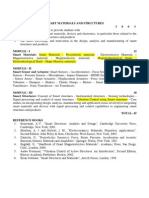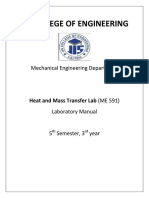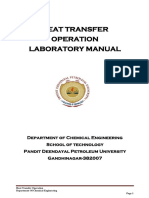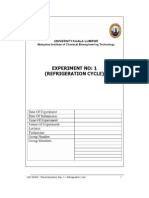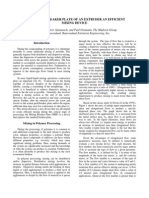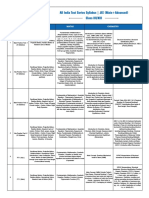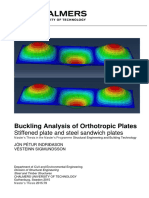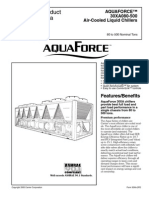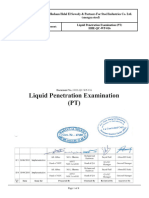20-21 Eme Lab 21eme Final
20-21 Eme Lab 21eme Final
Uploaded by
Aditya DiwanCopyright:
Available Formats
20-21 Eme Lab 21eme Final
20-21 Eme Lab 21eme Final
Uploaded by
Aditya DiwanCopyright
Available Formats
Share this document
Did you find this document useful?
Is this content inappropriate?
Copyright:
Available Formats
20-21 Eme Lab 21eme Final
20-21 Eme Lab 21eme Final
Uploaded by
Aditya DiwanCopyright:
Available Formats
Department of Mechanical Engineering
Elements of Mechanical Engineering
21EME15
Laboratory Assessment Report
B.E - I Semester
Name of the Student :
Semester /Section :
USN/Roll No :
Branch :
Academic Year 2021-22
Department of Mechanical Engineering
Certificate
This is to Certify that Mr./Miss ___________________________
bearing USN ___________ has satisfactorily completed the course of
Experiments in Elements of Mechanical Engineering practical
Assessment prescribe by the Visvesvaraya Technological University
for __ Semester in the assessment during the year of 2021-22.
Obtained Marks Total
Sl.
Title of the experiment Experimentati Marks
No Viva (05)
on (15) (20)
1 Thermal Conductivity of Metal Rod
2 Vapour compression Refrigeration
3 4-Stroke Petrol Engine
4 4-Stroke Diesel Engine
5 Pelton Wheel
6 Lathe Operations
Average Marks
Staff In-changer
Department of Mechanical Engineering, JCET, Hubballi
Contents:
01. To determine the Thermal Conductivity of Metal Rod
02. To demonstrate the working of vapor compression refrigeration system and calculate
its capacity and performance.
03. To conduct performance test on 4 - stroke Air Cooled Petrol Engine
04. To conduct performance test on four - stroke water Cooled diesel Engine
05. To study the working principle of Pelton (impulse) turbine
06. To perform different Operations on Lathe Machine.
Department of Mechanical Engineering, JCET, Hubballi
EXPERIMENT-01
THERMAL CONDUCTIVITY OF METAL ROD APPARATUS
AIM: To determine the thermal conductivity of the given metal rod
INTRODUCTION:
Thermal conductivity is the physical property of material denoting the ease with a
particular substance can accomplish the transmission of thermal energy by molecular motion.
Thermal conductivity of a material is found, to depend on the chemical composition of the
substances of which it is a composed, the phase (i.e. gas, liquid or solid) in which it’s crystalline
structure if a solid, the temperature & pressure to which it is subjected and whether or not it is
homogeneous material.
DESCRIPTION:
The apparatus consists of the Aluminum rod of 200 mm test section. Heat is provided
by means of band heater at one end and released through water jacket arrangement.
Thermocouples are provided at the suitable points to measure the surface and inner
temperatures. Proper insulation is provided to minimize the heat loss. The temperature is shown
by means of the digital temperature indicator on the control panel, which also consists of heater
regulator and other accessories instrumentation having good aesthetic looks and safe design.
Fig 1. Thermal conductivity measuring apparatus
PROCEDURE:
1. Give necessary electrical and water connections to the instrument.
2. Switch on the MCB and console ON to activate the control panel.
3. Give input to the heater by slowly rotating the heater regulator.
4. Start the cooling water supply through the water jacket (make sure not to exceed 2 lpm)
5. Note the temperature at different points, when steady state is reached.
Department of Mechanical Engineering, JCET, Hubballi
6. Repeat the experiment for different heater input.
7. After the experiment is over, switch off the electrical connections, allow the water to
flow for some time in the water jacket and then stop it.
TABULAR COLUMN:
Rota meter reading Temp. of Metal Rod Water
Sl in (R) (Surface) Temp.
No
LPM Kg/sec T1 T2 T3 T4 T5 T6
CALCULATIONS:
Heat carried away by water
𝑄𝑤 = 𝑚𝑤 𝐶𝑝𝑤 𝛥𝑇
mw = Mass of flow rate of water in kg/sec
Cpw = Specific heat of water = 4.178 KJ / Kg 0K
T = T5 – T6
k = Thermal conductivity of insulating powder
q = Heat flux
PLOT THE GRAPH
dT dT
dx
dX
Fig 2. Temp. v/s distance [dT v/s dx] and find out the temperature gradient [dT / dx]
𝒅𝑻
Also 𝑚𝑤 𝐶𝑝𝑤 𝛥𝑇 = −𝑲𝑨 𝒅𝒙
Where A = c/s area of metal rod [πd2/4], d = 0.05 m = diameter of the metal rod
K is the thermal conductivity of metal rod in (W/mºK)
Department of Mechanical Engineering, JCET, Hubballi
SPECIFICATION
Metal rod : Aluminum
Total length of the metal bar : 200 mm
Diameter of the Metal rod : 50 mm
Distance between two consecutive thermocouple : 50 mm(T5 to T6)
WORK SHEET:
Result: Thermal conductivity of the given metal rod is__________ W/m ºK
Department of Mechanical Engineering, JCET, Hubballi
EXPERIMENT-02
PERFORMANCE TEST ON VAPOR COMPRESSION REFRIGERATION TEST
RIG
AIM: To demonstrate the working of vapor compression refrigeration system and calculate its
capacity and performance (COP).
INTRODUCTION:
The ideal thermodynamic cycle on which the refrigerator works is the vapor compression cycle
shown in the following figure, on both T – s and p – h coordinates:
Fig 3. Vapour Compression cycle
The cycle consists of four processes:
Process 1-2: The refrigerant vapor leaving the evaporator is compressed isentropically from
state 1 to 2. In the ideal cycle state 1 corresponds to the saturated vapor state for the evaporator
temperature. At state 2 the pressure is equal to the condenser pressure and entropy = entropy
at state 1.Work compression, per kg refrigerant, Wc is given by:
Wc = (h2 – h1)
Process 2-3: During the constant pressure process 2-3 the compressed vapor at state 2 is cooled
to the saturation temperature tc, also called the condensing temperature , and then condensed
to saturated liquid at state 3. The magnitude of rejected by the condenser Qc is given by:
Qc = (h2 – h3) where h3 = hflp = pc
Process 3-4: The high pressure liquid at state 3, at the condenser pressure, is throttled during
3-4 to evaporator pressure at 4 by passing it through either an expansion valve or a capacity.
During throttling process there is no change in enthalpy.
Process 4-1: This is the process during which cooling is realized .Liquid entering the evaporator
at state 4 , picks up heat from the refrigerator at the evaporator temperature (te) and leaves the
evaporator at state 1 as saturated vapor. The cooling produced per kg refrigerant, Qe is given
by:
Qe = (h1 – h) where h1 = hglp = pe
The COP of the refrigerator is given by:
Q h −h
COP = e = 1 4
Wc h2 − h1
Department of Mechanical Engineering, JCET, Hubballi
EXPERIMENTAL TEAT RIG:
The experimental set up is an actual vapor compression refrigeration system with provisions to
measure pressures and temperature at various locations. Both options ,capillary tube and an
expansion valve, are available in the system to expand the refrigerant between the condenser
and the evaporator, The COP can be computed, with the help of the experimental observations
the refrigerant used in the system is R 134 a.
Fig 4. Vapour Compression Refrigeration Test Rig
PROCEDURE:
1. Switch – ON the mains and the console.
2. Keep either the throttle valve or the capillary tube open both devices have the same
expansion (or throttling) effect.
3. Switch – ON the motor which drives the compression and the fan (which cools the
condenser)
4. The refrigerant passes through the vapor compression cycle as mentioned earlier resulting
in cooling in evaporator chamber or freezer.
5. Wait for about 5 minutes and note the temperature T1 to T5 and pressures P1 and P2.
T1 = Temperature at compressor inlet (°C)
T2 = Temperature at compressor outlet (°C)
T3 = Temperature at condenser outlet (°C)
T4 = Temperature at evaporator inlet (°C)
T5 = Temperature inside freezer
P1 = Pressure upstream of the compressor, Kg/cm2
P2 = Pressure downstream of the compressor, Kg/cm2
6. The temperatureT5 in the freezer denotes the refrigeration process.
Note the power input (P) to the compressor
Department of Mechanical Engineering, JCET, Hubballi
7. Using the measured temperatures, pressures and power input to the compressor, the co-
efficient of performance and the capacity of the refrigerator can be determined using the
procedure given below.
OBSERVATION TABLE:
Temperatures at key P condenser P evaporator Tw in
Voltmeter Ammeter
Sl. Points (oC) P2 P1 o
C
No
V I t1 t2 t3 t4 psi bar psi bar t5
1
2
3
4
t1, t2,t3 and t4 are the temperature at states 1,2,3 and 4 respectively
DATA:
Electro-mechanical efficiency of the motor-compressor combination, ηele = 70%
1 psi = 6.8027 kPa or 6.8027 x 10-3 Mpa
CALCULATIONS : COP
h −h
1. COP = 1 4
h2 − h1
Read from p–h chart or property tables R 134 a, the following enthalpies and use them in the
above relation to get the theoretical COP.
H1 = Enthalpy of the refrigerant at exit of the evaporator.
H2 = Enthalpy of the refrigerant at exit of the compressor.
H3 = Enthalpy of the refrigerant at exit of the condenser.
H4 = Enthalpy of the refrigerant at exit of the throttle valve/capillary tube.
Note: The values of enthalpies of the refrigerant at different states are obtained from pressure-
enthalpy chart provided.
H1 is obtained for Temperature T1 and Pressure P2
H2 is obtained for Temperature T2 and Pressure P2
H3 is obtained for Pressure P2
H4 = H3
2. HP PER TON OF REFRIGERENT, HP/TON
4.715
HP / Ton =
COP
3. TONS OF REFRIGERENT, TON
TON = P HP / Ton
Department of Mechanical Engineering, JCET, Hubballi
Department of Mechanical Engineering, JCET, Hubballi
RESULTS:
The Co-efficient of Performance of given refrigerant is _________
Tons of Refrigerant = tons
Department of Mechanical Engineering, JCET, Hubballi
EXPERIMENT NO 03
SINGLE CYLINDER, FOUR STROKE PETROL ENGINE TEST RIG
AIM: To conduct performance test on 4 - stroke Air Cooled Petrol Engine
DESCRIPTION:
The Test Rig consists of Four-Stroke Petrol Engine to be tested for performance is
connected to an alternator coupled to electrical coils to apply load on engine. The arrangement
is made for the following measurements of the set-up:
1. The Rate of Fuel Consumption is measured by using the Burette reading against the known
time
2. The water flow rate for exhaust gas calorimeter is measured separately by measuring jar &
stop clock.
3. The load to the engine applied by coils which are all coupled with alternator.
4. The engine speed (RPM) is measured by digital counter.
5. Temperature at different points is measured by electronic digital temperature indicator with
thermocouple.
The whole instrumentation is mounted on a self-contained unit ready for operation.
ENGINE SPECIFICATIONS:
➢ TYPE : 4-Stroke petrol Engine (Air cooled)
➢ MAKE : Greves
➢ RATED POWER OUTPUT : 3 HP, 3000 RPM.
➢ BORE DIAMETER ‘ D ‘ : 70mm
➢ STROKE LENGTH ‘ L ‘ : 66.7mm
➢ COMPRESSION RATIO : 16.5 : 1
➢ CYLINDER CAPACITY : 553 cc
➢ STARTING : By Hand Cranking.
➢ DIA OF ORIFICE : 18 mm.
OPERATION:
1. Check the petrol in the Petrol tank.
2. Allow Petrol, start the engine by using hand cranking.
3. The engine is set to the speed of 1500 RPM.
4. Apply load from switches given on the panel
5. Note down the time taken for particular quantity of fuel consumed by the engine from
the burette
6. Note down the diff. temperatures.
7. Repeat the procedure (5) to (9) for different loads.
8. Tabulate the readings as shown in the enclosed sheet.
9. After the experiment is over, keep the Petrol control valve at closed.
RUNNING THE ENGINE:
The fuel level, cooling arrangement and lubricating system are checked. The engine is
started by hand cranking. For this, the decompression lever is set in the vertical position. The
crank shaft is rotated by hand cranking till sufficient energy is gained by the flywheel (to over
come the compression pressure). Immediately the decompression lever is knocked down and
Department of Mechanical Engineering, JCET, Hubballi
the fuel system is put into action by releasing the lever of the fuel pump. The engine is allowed
to run idle for 5 minutes to achieve steady state.
READINGS TO BE TAKEN:
1. To determine the Fuel Consumption Rate:
The fuel supply from the fuel tank to engine is disconnected by means of 3-way
distributed which is provided on the right side of the control panel. The engine receives fuel
from measuring pipette tube. The fuel level in the pipette starts decreasing. The time‘t ‘sec
for the consumption of known volume ‘v’cc. Of fuel is noted by using a stopwatch.
2. To determine Brake Power:
The speed of the engine ‘N ‘RPM and the effective load applied by electrical heaters
should be noted down. or voltage and current should be noted down.
Fig 5. Single cylinder Four Stroke Petrol Engine Test Rig
PRECAUTIONS:
1. Do not run the engine without fuel supply.
2. Do not shut down the engine when maximum load applied to Engine.
Department of Mechanical Engineering, JCET, Hubballi
3. After completion of experiments turn off the fuel supply valve.
4. Change engine oil when oil turns to black color.
5. Frequently at least once in three months, grease all visual moving parts.
6. At least every week, operate the unit for five minutes to prevent any clogging of the moving
parts.
TABULAR COLOUMN:
Speed Voltmeter Time for fuel Temperatures
Load Current in Manometer reading
in rpm reading in Consumption in °C
in KW amps in mm (hw = h1-h2)
(N) volts for 10ml
T1 T2
CALCULATIONS
1. BRAKE POWER (BP):
V I
BPshaft = KW.
1000 g
Where,
V = Volts
A = Amps
ηg = Generator Efficiency = 0.70 (70%)
2. MASS OF FUEL CONSUMED (mf):
10 P 3600
mf = Kg / min.
T 1000
Where,
= density of petrol, Volume of pipette =pipette reading
= 0.72 gm/ml
T = Time for 10ml of fuel consumption in sec
3. HEAT INPUT ( HI ) :
HI = m f CV KW
Where,
CV = Calorific Value of petrol = 41500 KJ/Kg (approx.)
mf = Mass of fule consumed in kg/hr
4. BRAKE THERMAL EFFICIENCY (ηBth):
BP
Bth = 100
HI
Department of Mechanical Engineering, JCET, Hubballi
Department of Mechanical Engineering, JCET, Hubballi
Result: Brake Thermal efficiency of 4-stroke petrol engine is ______%
Department of Mechanical Engineering, JCET, Hubballi
EXPERIMENT NO 04
FOUR STROKE, SINGLE CYLINDER, DIESEL ENGINE TEST RIG
(Mechanical Brake Load with Exhaust gas Calorimeter & Water Cooled)
AIM: To conduct performance test on four - stroke water Cooled diesel Engine
DESCRIPTION:
The Test Rig consists of Four-Stroke diesel Engine (WATER Cooled) to be tested for
performance is coupled to break drum assembly. The arrangement is made for the following
measurements of the set-up.
1) The Rate of Fuel Consumption is measured by using Volumetric Pipette.
2) Air Flow is measured by Manometer, connected to Air Box.
3) The different mechanical loading is achieved by loading the engine through rope –
break drum assembly attached to weighing balance.
4) The engine speed is measured by electronic digital meter.
5) Temperature at air inlet, engine exhaust gas, engine water inlet and outlet and
calorimeter inlet and outlet are measured by electronic digital temperature indicator
with thermocouple.
6) Water flow is measured by water flow meter or rotameter.
The whole instrumentation is mounted on a self-contained unit ready for operation.
SPECIFICATIONS:
➢ ENGINE TYPE : 4-Stroke, Single Cylinder Diesel Engine
➢ MAKE : Kirloskar.
➢ MAXIMUM POWER, ‘P’ : 5 HP.
➢ RATED SPEED, ‘N’ : 1500 RPM.
➢ BORE, ‘D’ : 80mm.
➢ STROKE, ‘L’ : 110mm.
➢ STARTING : By Hand cranking
➢ LOADING : Rope break dynamometer assembly
➢ COOLING : Water cooling.
MEASUREMENTS:
➢ AIR INTAKE : By Volumetric Tank with Orifice Diameter (d = 0.020m)
connected to Manometer (water), Cd = 0.62
➢ SPEED : By digital RPM indicator.
➢ FUEL FLOW : By Volumetric Pipette.
OPERATION:
1) Check the diesel in the tank.
2) Allow diesel and start the engine by using Hand crank.
3) Keep the weighing balance to read zero position, initially.
4) Apply the Load to engine by adjusting the weighing balance
5) Allow some time so that the speed stabilizes.
6) Now take down temperature, petrol flow rate and air consumption.
7) Repeat the procedure (4) & (6) for different loads.
8) Tabulate the readings as shown in the enclosed sheet.
9) After the experiment is over, keep the petrol control valve closed
Department of Mechanical Engineering, JCET, Hubballi
Fig 6. Single cylinder four stroke Diesel Engine Test Rig
TABULAR COLOUMN:
Air flow
Fuel
Engine manometer
consumption
speed Load reading in Temperature in °C Water Flow rate (LPM)
readings
(N) mm of
(for 10 ml)
water
To To Engine
in rpm in kg Time in Sec hm= h1 - h2 T1 T2 T3 T4 T5 T6
Calorimeter Jacket
NOTE: TEMPERATURE POINTS,
T1 = AIR INLET TEMPERATURE,
T2 = ENGINE HEAD WATER INLET.
T3 = ENGINE HEAD WATER OTLET
T4 = EXHAUST GAS OUTLET TEMPERATURE
T5 = WATER INLET TEMPERATURE FOR CALORIEMETER
T6 = WATER OUTLET TEMPERATURE FOR CALORIEMETE
Department of Mechanical Engineering, JCET, Hubballi
CALCULATIONS:
1. BRAKE POWER (BP):
2 N 9.81 F r
BP = KW
60 1000
Where,
N = RPM of Engine
r = Radius of Brake drum = 0.156 m
F = in Kgf read from Spring Balance (F)
2. MASS OF FUEL CONSUMED ( mf ) :
V P 3600
mf = Kg / hr.
T 1000
Where,
V = Fuel consumed in burret for 10ml or 10cc
ρ = density of Diesel = 0.8 g/ml
P
T = time taken for fuel flow
3. BRAKE THERMAL EFFICIENCY ( b):
BP
b = 100
HI
m f CV
HI = Where CV = 39000 KJ/Kg
60 60
Department of Mechanical Engineering, JCET, Hubballi
Result: Brake Thermal efficiency of 4-stroke diesel engine is ______%
Department of Mechanical Engineering, JCET, Hubballi
Experiment No. 05
PELTON TURBINE TEST RIG
AIM:
To study the working principle of Pelton (impulse) turbine
INTRODUCTION:
Hydraulic (or water) Turbines are the machines, which use the energy of water (Hydro –
power) and convert it into Mechanical energy. Thus the turbine becomes the prime mover to
run the electrical generators to produce the electricity, viz., hydroelectric power.
The Turbines are classified as impulse & reaction types. In impulse turbine, the head of
water is completely converted into a jet, which impinges on the turbine runner, it is the pressure
of the flowing water, which rotates the runner of the turbine. Of many types of turbines, the
Pelton turbine, most commonly used, falls into the category of impulse turbine while the
Francis & Kaplan falls into the category of reaction turbines.
Normally, Pelton turbine (impulse) requires high heads and low discharge, while the
Francis & Kaplan (reaction turbines) require relatively low heads and high discharge. These
corresponding heads and discharges are difficult to create in laboratory size turbine as the
limitation of the pump’s availability in the market. Nevertheless, at least the performance
characteristics could be obtained within the limited facility available in the laboratories.
Further, understanding various elements associated with any particular turbine is possible with
this kind of facility.
DESCRIPTION:
The experimental setup consists of Centrifugal pump set, Turbine unit, sump tank, notch tank
arranged in such a way that the whole unit works as recirculation water system. The centrifugal
pump set supplies the water form the sump tank to turbine through control valve situated on
the pump and a sphere valve before entering the turbine. The water after passing through the
Turbine unit enters the Notch tank and then flows back to sump tank through the Notch tank
which is fixed with a notch plate for measurement of flow rate.
Fig 7. Pelton Turbine Test Rig
Department of Mechanical Engineering, JCET, Hubballi
The loading of the turbine is achieved by a brake drum with rope & spring balance,
provision for measurement of turbine speed (digital RPM indicator), Head on turbine (pressure
gauge) are built in on the control panel.
SPECIFICATION:
Supply pump capacity : 7.5Hp, 3ph, 440V
Turbine capacity : 1.1 kW
Run away speed : 1500 rpm
Loading : Brake drum with spring balance
OBSERVATION TABLE:
PROCEDURE:
1) Connect the panel to the electrical source & ascertain the direction of the pump is in
order (clock wise direction from shaft end) by momentarily starting the pump.
2) Fill filtered clear water into the sump tank up to ¾th its full capacity
3) Keep the control valve situated above the pump in fully closed position, and the sphere
valve in half open position.
4) Start the pump; gradually open the control valve slowly so that the turbine achieves
sufficient speed.
5) Wait till the speed of the turbine maintained constant.
6) Load the turbine by turning the hand wheel situated on the load frame clock wise
observing the dial spring balance to any desired minimum load
7) Allow the turbine speed to stabilize
8) Record the readings indicated on pressure gauge, dial balance RPM indicator and head
over the notch plate
9) Continue loading the turbine in steps up to its full load and record the corresponding
readings at each steps
10) After the experiment is over bring the turbine to no load condition by rotating the hand
wheel on the load frame in anti clock wise direction and stop the pump.
11) Tabulate all the recorded readings and calculate the input power, output power &
efficiency of the Turbine.
TABULAR COLUMN:
Constant Head:
Spring
Head over
Head balance
Turbi Pr the venturi- Turbine
over reading Flow
ne Gauge meter Input Brake efficien
Sl turbine Kg rate
speed reading h2- power power cy
No ‘H = P h1=h*10 in ‘Q’
’N’ ‘P’ kW Bp kW %
* 10’ in m S2-S1= S m3/s
rpm Kg/cm2 η turb
m
h1 h2 hm S1 S2 S
1
2
3
Department of Mechanical Engineering, JCET, Hubballi
CALCULATIONS:
A1 = …………m2 A2 = …………m2
1. Water Flow Rate:
𝐶𝑑 × 𝐴1 × 𝐴2 √2𝑔ℎ𝑤
𝑄=
√𝐴12 − 𝐴22
ℎ𝑚 × 12.6
ℎ𝑤 =
1000
2. Output Power:
2𝜋𝑁𝑇
𝑂𝑃 =
60
3. Input Power:
𝐼𝑃 = 𝜌𝑄𝑔ℎ
4. Efficiency of Turbine:
𝑂𝑃
𝜂= × 100
𝐼𝑃
Department of Mechanical Engineering, JCET, Hubballi
Result: Efficiency of Pelton Turbine is_______%
Department of Mechanical Engineering, JCET, Hubballi
Experiment No - 06
PART-A
ENGINE LATHE
A lathe is a machine tool which rotates the work piece on its axis to perform various operations
such as cutting, sanding, knurling, drilling, or deformation with tools that are applied to the
work piece to create an object which has symmetry about an axis of rotation.
Lathes are used in woodturning, metalworking, metal spinning, and glass working. Lathes can
be used to shape pottery, the best-known design being the potter's wheel. Most suitably
equipped metalworking lathes can also be used to produce most solids of revolution, plane
surfaces and screw threads or helices. Ornamental lathes can produce three-dimensional solids
of incredible complexity. The material can be held in place by either one or two centers, at
least one of which can be moved horizontally to accommodate varying material lengths. Other
work holding methods include clamping the work about the axis of rotation using a chuck or
collet, or to a faceplate, using clamps or dogs.
Examples of objects that can be produced on a lathe include candlestick holders, cue sticks,
table legs, bowls, baseball bats, musical instruments (especially woodwind instruments),
crankshafts and camshafts. The parts of the Lathe are illustrated in Fig 7.
Fig 8. Lathe machine
Department of Mechanical Engineering, JCET, Hubballi
The Bed: The lathe bed is a mounting and aligning surface for the other machine components.
Viewed from the operating position in front of the machine, the headstock is mounted on the
left end of the bed and the tailstock on the right. The bed must be bolted to a base to provide a
rigid and stable platform. The bed ways are a precision surface (or surfaces) on which the
carriage slides left and right during machining operations. The ways are machined straight and
flat and are either bolted to the top of the bed or are an integrally machined part of the bed.
Headstock: The headstock holds the spindle and drive mechanism for turning the work piece.
The spindle is a precision shaft and bearing arrangement rotated directly by a motor or through
a motor-driven belt. Gears or sliding pulleys mounted at the rear of the headstock allow spindle
speed adjustment. A work piece is held in the spindle for turning or drilling by a jawed chuck
or a spring collect system. Large, unusual shaped, or otherwise difficult to hold pieces, can be
attached to the spindle with a face plate, drive dogs and special clamps.
Tailstock: The tailstock supports long work that would otherwise sag or flex too much to allow
for accurate machining. Without a tailstock, long pieces cannot be turned straight and will
invariably have a taper. Some tailstocks can be intentionally misaligned to accurately cut a
taper if needed. The tailstock has a centering device pressed into a shallow, specially drilled
hole in the end of the work piece. The center can be either "live" or "dead." Live centers have
a bearing, allowing the center to rotate along with the work piece. Dead centers do not rotate
and must be lubricated to prevent overheating due to friction with the work piece. Instead of a
center, a drill chuck can be mounted in the tailstock.
Carriage: The carriage provides mounting and motion control components for tooling. The
carriage moves left and right, either through manual operation of a hand wheel, or it can be
driven by a lead screw. At the base of a carriage is a saddle that mates and aligns with the bed
ways. The cross-slide, compound rest and tool holder are mounted to the top of the carriage.
Some carriages are equipped with a rotating turret to allow a variety of tools to be used in
succession for multi-step operations.
Cross Slide: The cross-slide is mounted to the top of the carriage to provide movement
perpendicular to the length of the bed for facing cuts. An additional motion assembly, the
compound rest, with an adjustable angle, is often added to the top of the cross slide for angular
cuts. The cutting tools that do the actual metal removal during turning are mounted in an
adjustable tool holder clamped to the compound rest.
Lead Screw: The lead screw provides automatic feed and makes thread cutting possible. It is a
precision-threaded shaft, driven by gears as the headstock turns. It passes through the front of
the carriage apron and is supported at the tailstock end by a bearing bracket. Controls in the
apron engage a lead nut to drive the carriage as the lead screw turns.
Department of Mechanical Engineering, JCET, Hubballi
Fig 9. Parts Lathe machine
Specifications of the Lathe
1. Swing over machine bed
2. Swing over cross slide
3. Distance between centers
4. Turning Length
5. Width of bed
6. Work Spindle diameter in front bearing
7. Spindle Bore
8. Taper bore according to DIN 228(shortened)
9. Normal Chuck diameter
10. Max. Diameter of face plate and clamping disk
11. Tool Slide & Guide Length of carriage
12 Graduation of Longitudinal scale on apron box hand wheel
13 Cross-slide travel
14 Graduation of scale at cross slide spindle
15 Width of cross-slide
16 Compound slide travel
17 Graduation of scale on compound slide spindle
18 Width of top slide
Department of Mechanical Engineering, JCET, Hubballi
19 Tailstock with hand wheel
20 Diameter of center sleeve
Types of Lathe
Engine Lathe
The most common form of lathe, motor driven and comes in large variety of sizes and shapes.
Bench Lathe
A bench top model usually of low power used to make precision machine small work pieces.
Tracer Lathe
Lathe that has the ability to follow a template to copy a shape or contour.
Automatic Lathe
Lathe in which the work piece is automatically fed and removed without using an operator.
Cutting operations are automatically controlled by a sequencer of some form
Turret Lathe
lathe which have multiple tools mounted on turret either attached to the tailstock or the cross-
slide, which allows for quick changes in tooling and cutting operations.
Computer Controlled Lathe
A highly-automated lathe, where both cutting, loading, tool changing, and part unloading are automatically
controlled by computer coding.
CONVENTIONAL TYPES OF LATHE
Fig 10. Conventional Type of Lathe
Lathe Operations
Turning: produce straight, conical, curved, or grooved work pieces
Facing: to produce a flat surface at the end of the part or for making face grooves.
Boring: to enlarge a hole or cylindrical cavity made by a previous process or to produce
circular internal grooves.
Department of Mechanical Engineering, JCET, Hubballi
Drilling: to produce a hole by fixing a drill in the tailstock
Threading: to produce external or internal threads
Knurling: to produce a regularly shaped roughness on cylindrical surfaces
Work Holding Devices
Three jaw chuck: For holding cylindrical stock centered and for facing/center drilling the end
of your aluminum stock.
Four-Jaw Chuck: - This is independent chuck generally has four jaws , which are adjusted
individually on the chuck face by means of adjusting screws
Collet Chuck: Collet chuck is used to hold small work pieces
Magnetic Chuck: Thin jobs can be held by means of magnetic chucks.
Fig 11. Three jaw chuck Fig 12. Four jaw chuck
Fig13. Collet Chuck Fig 14. Magnetic Chuck
Department of Mechanical Engineering, JCET, Hubballi
GENERAL PURPOSE CUTTING TOOLS
The lathe cutting tool or tool bit must be made of the correct material and ground to the correct
angles to machine a workpiece efficiently. The most common tool bit is the general all-purpose
bit made of high-speed steel. These tool bits are generally inexpensive, easy to grind on a bench
or pedestal grinder, take lots of abuse and wear, and are strong enough for all-around repair
and fabrication. High-speed steel tool bits can handle the high heat that is generated during
cutting and are not changed after cooling. These tool bits are used for turning, facing, boring
and other lathe operations. Tool bits made from special materials such as Single point tool bits
can be one end of a high-speed steel tool bit or one edge of a carbide or ceramic cutting tool or
insert. Basically, a single point cutter bit is a tool that has only one cutting action proceeding
at a time. A machinist or machine operator should know the various terms applied to the single
point tool bit to properly identify and grind different tool bits
SINGLE POINT TOOL BITS
The shank is the main body of the tool bit. The nose is the part of the tool bit which is shaped
to a carbide, ceramics, diamonds, cast alloys are able to machine workplaces at very high
speeds but are brittle and expensive point and forms the corner between the side cutting edge
For normal lathe work, high-speed steel tool bits are used. The nose radius is the rounded end
of the tool bit.
The face is the top surface of the tool bit upon which the chips slide as they separate from the
work piece. The side or flank of the tool bit is the surface just below and adjacent to the cutting
edge. The cutting edge is the part of the tool bit that actually cuts into the workpiece, located
behind the nose and adjacent to the side and face. The base is the bottom surface of the tool bit,
which usually is ground flat during tool bit manufacturing. The end of the tool bit is the near-
vertical surface which, with the side of the bit, forms the profile of the bit. The end is the trailing
surface of the tool bit when cutting. The heel is the portion of the tool bit base immediately
below and supporting the face.
Fig 15. Nomenclature of single point cutting tool
MACHINING
Machining is a manufacturing process in which a cutting tool is used to remove excess material
from a workpiece. The material that remains is the desired part geometry. The cutting tool
deforms the workpiece in shear and creates scrap called “chips.” As chips fall off the workpiece
a new surface is exposed. Almost all solid metals, plastics, and composites can be machined
Department of Mechanical Engineering, JCET, Hubballi
by conventional machining. Machining can create any regular geometry, i.e., planes, round
holes, and cylinders. Machining can produce dimensions to tolerances of less than 0.001”
(0.025mm) Surface finishes of better than 16μin (0.4 μm) can be produced by machining
processes. A cutting tool has one cutting edge (facing tool or turning tool) or more than one
cutting edges (drill, end mill). The cutting edge separates the chip from the workpiece.
Fig 16. Formation of chip
The rake face of a tool guides the chip from the surface of the workpiece and is oriented at an
angle α. The rake angle α is measured relative to a plane perpendicular to the work surface.
The flank of a tool provides clearance between the cutting tool and the newly exposed surface
to protect the surface from abrasion. The flank is oriented at an angle called the relief angle.
The picture below illustrates the make-up of a cutting tool.
Fig 17. Nomenclature of tool-workpiece interphase
Discontinuous chips: This type of chip is usually formed when cutting hard, brittle materials,
partly because these materials cannot withstand high shear forces and therefore the chips
formed shear cleanly away. However, the chips formed may be firmly or loosely attached to
each other or may leave the cutting area in a fine shower – as often encountered when cutting
hard Brass. When discontinuous chips are formed, there is a greater possibility of tool chatter;
unless the tool, tool-holder and workpiece are held very rigidly; due to pressure at the tool tip
increasing during chip formation and then releasing suddenly as the chip shears.
Department of Mechanical Engineering, JCET, Hubballi
Continuous chips: This type of chip is usually formed when cutting soft or ductile materials
such as Aluminium or Copper. There is less likelihood of chatter and surface finish is usually
better than when discontinuous chips are formed. A disadvantage of continuous chips is the
fact that they can become very long and become entangled with the machine or pose a safety
hazard. This problem can be overcome by the use of chip-breakers; a device clamped to the top
of the tool that encourages the chip to curl more tightly, hitting the workpiece and breaking off.
Fig 18(a). Discontinuous chips Fig18(b). Continuous chips
Built Up Edge: Figure shows a tool with a Built-up Edge (B.U.E.). A B.U.E. is formed when
particles of the workpiece material weld to the rake face of the tool during cutting. Large
B.U.E.s can be very detrimental to surface finish and integrity, they effectively change the
geometry of the cutting edge and consequently shear plane angle, this can lead to residual
stresses in the material below the depth of cut. As a large B.U.E. dislodges it can deposit work
hardened particles, to become embedded in the finished surface. A thin, stable B.U.E. is
generally considered desirable as this can tend to reduce frictional wear on the rake face of the
tool.
Tool Wear: Wedge shape cutting tools normally wear in two ways. Figure shows the typical
wear pattern of a wedge shape cutting tool. Crater wear occurs on the rake face of the tool just
behind the cutting edge and is caused by the rubbing of the chip across the surface. Flank wear
occurs on the clearance angle of the tool causing rubbing and degradation of the surface finish.
Cutting tools are deemed to have failed and require regrinding or replacing when flank wear
exceeds 0.25mm or when cratering appears, this allows regrinding with minimal removal of
tool material. It can be seen from Figure that when cratering appears the cutting edge becomes
thinned and less able to dissipate the heat generated during cutting; leading to unpredictable
and possibly catastrophic, failure.
Fig 19. Phenomenon of Cratering
Department of Mechanical Engineering, JCET, Hubballi
With a neat sketch explain the following operations:
a. Turning
Department of Mechanical Engineering, JCET, Hubballi
b. Facing
Department of Mechanical Engineering, JCET, Hubballi
c. Taper Turning
(i) By swiveling (rotating) of compound rest
Department of Mechanical Engineering, JCET, Hubballi
c. Taper Turning
(ii) By off-setting the tailstock
Department of Mechanical Engineering, JCET, Hubballi
d. Knurling
Department of Mechanical Engineering, JCET, Hubballi
Department of Mechanical Engineering, JCET, Hubballi
You might also like
- Lab Report Air ConditioningDocument5 pagesLab Report Air ConditioningAzira Misman44% (9)
- Smart Materials and StructuresDocument1 pageSmart Materials and StructuresSathiyavathi SasikumarNo ratings yet
- Tutorial Depressuring 5Document26 pagesTutorial Depressuring 5Zhang Zhaoyang89% (9)
- RefrigerationDocument13 pagesRefrigerationSuvasish NathNo ratings yet
- Heat Transfer in Agitated VesselDocument5 pagesHeat Transfer in Agitated VesselinfoNo ratings yet
- Heat Transfer Lab ManualDocument40 pagesHeat Transfer Lab ManualRachit_Goyal25_10No ratings yet
- Energy Balance Across A Shell and Tube Heat ExchangerDocument13 pagesEnergy Balance Across A Shell and Tube Heat ExchangeroatsmartinNo ratings yet
- Fall 2016 Lab Manual - CHEG455 (Sec 51 & 52) PDFDocument68 pagesFall 2016 Lab Manual - CHEG455 (Sec 51 & 52) PDFMashaelNo ratings yet
- Practical GuideDocument10 pagesPractical GuideDamaris ThamiNo ratings yet
- MEC 595 Thermal and Design LabDocument53 pagesMEC 595 Thermal and Design Labraipardeep9600No ratings yet
- Diseño IntercambiadorDocument9 pagesDiseño IntercambiadorMateo VanegasNo ratings yet
- Heat Transfer Lab ManualDocument44 pagesHeat Transfer Lab ManualNaveen luckyNo ratings yet
- MPU-Heat-and-Mass-Transfer-Lab mannualDocument42 pagesMPU-Heat-and-Mass-Transfer-Lab mannualkajalrawatr247No ratings yet
- Power Lab #3 (Surface Condenser)Document4 pagesPower Lab #3 (Surface Condenser)Mahmud L. MusaNo ratings yet
- Me 6512 Thermal Engineering Lab Manual 2013 RegulationDocument94 pagesMe 6512 Thermal Engineering Lab Manual 2013 RegulationSujith JNo ratings yet
- Thermo Exp Refrigeration Cycle ReportDocument11 pagesThermo Exp Refrigeration Cycle Reportbaemaejor100% (1)
- Report 2 - Thermal Conductivity 2.12.15Document9 pagesReport 2 - Thermal Conductivity 2.12.15LegendaryNNo ratings yet
- Heat Transfer Laboratory ManualDocument18 pagesHeat Transfer Laboratory ManualHmnxu 99No ratings yet
- Air Water Heat PumpDocument14 pagesAir Water Heat PumpKeshav GopaulNo ratings yet
- HT Ex-9Document9 pagesHT Ex-9shaktipratap232324No ratings yet
- Air water heat exchanger , ,WWW ��Document12 pagesAir water heat exchanger , ,WWW ��abaditutuNo ratings yet
- Heat Transfer Operation-I Manual 2015-16Document22 pagesHeat Transfer Operation-I Manual 2015-16Arbaz AKNo ratings yet
- VAC Lab Manual EXP1-11Document20 pagesVAC Lab Manual EXP1-11Shaheer AliNo ratings yet
- HMT (ME-701)Document19 pagesHMT (ME-701)shuklavanishNo ratings yet
- Heat and Mass Transfer ManualDocument30 pagesHeat and Mass Transfer ManualSushil ThakkarNo ratings yet
- HMT Lab ManualDocument33 pagesHMT Lab ManualMahikant JhaNo ratings yet
- Heat Transfer Lab Observaton: Sri Venkateswara College of Engineering and TechnologyDocument66 pagesHeat Transfer Lab Observaton: Sri Venkateswara College of Engineering and TechnologyMd Naim HossainNo ratings yet
- Exp. 1 EFFECT OF FLOW RATE IN THE EFFECTIVENESS OF SHELLTUBE HEAT EXCHANGERDocument6 pagesExp. 1 EFFECT OF FLOW RATE IN THE EFFECTIVENESS OF SHELLTUBE HEAT EXCHANGERdiwaniiNo ratings yet
- Lab Heat PumpDocument9 pagesLab Heat PumpShahran IezzatNo ratings yet
- HT Lab Manual FinalDocument58 pagesHT Lab Manual Finalsharadesh sarnaikNo ratings yet
- 1 s2.0 S0735193305001041 MainDocument9 pages1 s2.0 S0735193305001041 MainAndika RivaldiNo ratings yet
- Experiment For THT3701 - 2022Document8 pagesExperiment For THT3701 - 2022Kwenza ShanduNo ratings yet
- Shell and Tube Steam To WaterDocument5 pagesShell and Tube Steam To Waterjaikumar rajNo ratings yet
- Lab Report 7 1Document6 pagesLab Report 7 1z06585964No ratings yet
- Manual For Experimental Water Cooling TowerDocument7 pagesManual For Experimental Water Cooling TowerBalRam Dhiman100% (1)
- Exp 1 SrivalliDocument6 pagesExp 1 Srivalliclmesahana.2003No ratings yet
- Heat Transfer Operation Manual-19-20Document60 pagesHeat Transfer Operation Manual-19-20Abhay RajputNo ratings yet
- Refrigeration & Air Conditioning Lab (Mey-303) Experiment No. 3 Aim: To Evaluate The Performance of Domestic Air ConditionerDocument9 pagesRefrigeration & Air Conditioning Lab (Mey-303) Experiment No. 3 Aim: To Evaluate The Performance of Domestic Air ConditionerIshwarjit SinghNo ratings yet
- Suyat Experiment-7Document8 pagesSuyat Experiment-7Lpt Ashley OlbinarNo ratings yet
- Heat Transfer Characteristics of Fan Coil Unit FCUDocument6 pagesHeat Transfer Characteristics of Fan Coil Unit FCUShehan WijesingheNo ratings yet
- Laboratory Report No.8 Test of Tubular CondenserDocument5 pagesLaboratory Report No.8 Test of Tubular CondenserLouie Ludeña VillegasNo ratings yet
- Experiment No. 1Document4 pagesExperiment No. 1subhamgupta7495100% (1)
- Lab 1 Refrigeration CycleDocument8 pagesLab 1 Refrigeration Cycletengku30No ratings yet
- HMT Lab ManualDocument55 pagesHMT Lab ManualHarsha K100% (1)
- Energy Performance Assessment of Heat Exchangers: Overall Heat Transfer Coefficient, UDocument18 pagesEnergy Performance Assessment of Heat Exchangers: Overall Heat Transfer Coefficient, USATISH PAWARNo ratings yet
- Experimental Assessment of The Condenser at Off-Design ModesDocument6 pagesExperimental Assessment of The Condenser at Off-Design ModestatianaNo ratings yet
- Heat PipeDocument60 pagesHeat PipeInquiry XEEPLNo ratings yet
- Experiment 1.thermal Conductivity of Metal Rod-3Document6 pagesExperiment 1.thermal Conductivity of Metal Rod-3Prem ThakurNo ratings yet
- Metal RodDocument65 pagesMetal RodVidhya NairNo ratings yet
- MEE2005 Heat Transfer Lab ManualDocument114 pagesMEE2005 Heat Transfer Lab ManualAslam AzeezNo ratings yet
- Sub ReportDocument17 pagesSub ReportpachieduNo ratings yet
- Lab Manual Sem 1 2020-2021 PDFDocument24 pagesLab Manual Sem 1 2020-2021 PDFDinesh RaviNo ratings yet
- Heat Transfer Coefficient of Double Pipe Heat ExchangerDocument8 pagesHeat Transfer Coefficient of Double Pipe Heat ExchangerSushil KumarNo ratings yet
- HVAC (Heat - Ventilation - Air-Conditioning) : - Refrigeration - PsychrometricsDocument9 pagesHVAC (Heat - Ventilation - Air-Conditioning) : - Refrigeration - Psychrometricsmarjan 01No ratings yet
- B.V. Suryakiran 2016JES2908: To Study A Heat Pipe Heat Exchanger and Find Its EffectivenessDocument7 pagesB.V. Suryakiran 2016JES2908: To Study A Heat Pipe Heat Exchanger and Find Its EffectivenessSurya KiranNo ratings yet
- Experiment of HTDocument41 pagesExperiment of HTRonak ModiNo ratings yet
- Refrigeration TutorDocument7 pagesRefrigeration TutorTejas Vibhandik100% (2)
- ME - 4221 - Lab Manual - Exp - 01 - 02Document12 pagesME - 4221 - Lab Manual - Exp - 01 - 02Apurbo SahaNo ratings yet
- Refrigeration and Air Conditioning Laboratory: Lab Session 3 Absorption Refrigeration Demonstrator 816 ObjectivesDocument10 pagesRefrigeration and Air Conditioning Laboratory: Lab Session 3 Absorption Refrigeration Demonstrator 816 Objectivesjhon milliNo ratings yet
- Boiler Thermal Efficiency Determination at Steady State For Two Different ConditionsDocument4 pagesBoiler Thermal Efficiency Determination at Steady State For Two Different ConditionsAhmad A. MaaroofNo ratings yet
- FinalDocument7 pagesFinalRoky HarizanNo ratings yet
- Extrusion - Artical - Making The Breaker Plate of An Extruder and Efficient Mixing Device - Rios, Satanach, Gramann, RauwendaalDocument7 pagesExtrusion - Artical - Making The Breaker Plate of An Extruder and Efficient Mixing Device - Rios, Satanach, Gramann, RauwendaalOwner MonolithicNo ratings yet
- Technical Notes For The Tubing Pressure Table CalculatorDocument5 pagesTechnical Notes For The Tubing Pressure Table CalculatorbeymarNo ratings yet
- Cantilever Beam ReportDocument5 pagesCantilever Beam ReportJoseph TuzonNo ratings yet
- Jee Main Adv Xii CBT Aits SyllabusDocument3 pagesJee Main Adv Xii CBT Aits SyllabusLakshay GuptaNo ratings yet
- CH 6.changes Around Us - NotesDocument5 pagesCH 6.changes Around Us - Notesswetha swithinNo ratings yet
- Module 3: Lateral Earth Pressure: Engr. Vuangh Erick B. Barrantes, MSCDocument29 pagesModule 3: Lateral Earth Pressure: Engr. Vuangh Erick B. Barrantes, MSCKenneth Bryan FontanillasNo ratings yet
- Solar ChimneysDocument30 pagesSolar ChimneysChandan KumarNo ratings yet
- Applications of Van Der Waals EquationDocument4 pagesApplications of Van Der Waals EquationFajar Emman AsmatNo ratings yet
- Seismic Assessment of A R/C Building With Setbacks Using Nonlinear Static and Dynamic Analysis ProceduresDocument7 pagesSeismic Assessment of A R/C Building With Setbacks Using Nonlinear Static and Dynamic Analysis ProceduresAris CapNo ratings yet
- Buckling Analysis of Orthotropic Plates PDFDocument92 pagesBuckling Analysis of Orthotropic Plates PDFRayhan saiaf binNo ratings yet
- Penjelasan Slide PPT Liquefaction of SoilDocument14 pagesPenjelasan Slide PPT Liquefaction of Soilbasri kamaruddinNo ratings yet
- Stringham - Pinched Cavitation Jets and Fusion EventsDocument6 pagesStringham - Pinched Cavitation Jets and Fusion Events1mmahoneyNo ratings yet
- Enhancement of Bioavailability Pharm DDocument33 pagesEnhancement of Bioavailability Pharm DPallavi PNo ratings yet
- Brochure - Valco - Marine Valves - EnglishDocument8 pagesBrochure - Valco - Marine Valves - EnglishMeet JaniNo ratings yet
- Aquaforce 30XA080-500 Air Cooled ChillersDocument56 pagesAquaforce 30XA080-500 Air Cooled Chillerssriomprakash100% (1)
- Job InterviewDocument15 pagesJob Interviewnitin birajdarNo ratings yet
- 2021 AL Chemistry Marking Scheme English MediumDocument45 pages2021 AL Chemistry Marking Scheme English Mediumnisandidissara8bNo ratings yet
- DPT NewDocument62 pagesDPT Newmelwinroy2015No ratings yet
- Installing PACU and CRE ComponentsDocument42 pagesInstalling PACU and CRE ComponentsBeth AusteNo ratings yet
- Hhe QC WP 016Document8 pagesHhe QC WP 016omarNo ratings yet
- 1 s2.0 S0017931022005361 MainDocument39 pages1 s2.0 S0017931022005361 Mainmosab.backkupNo ratings yet
- Physics Notes On Waves, Lens, Sound CompliedDocument32 pagesPhysics Notes On Waves, Lens, Sound CompliedFARHAN SADIQUENo ratings yet
- Parathom Classic A 75 Adv 11 W 827 E27Document4 pagesParathom Classic A 75 Adv 11 W 827 E27Stan EduardNo ratings yet
- Chapter 11Document23 pagesChapter 11HemantNo ratings yet
- Water CycleDocument6 pagesWater CycleVal Daryl AnhaoNo ratings yet
- US3157466Document13 pagesUS3157466Nateek SharmaNo ratings yet
- Physical SCience Lesson 4 The Structure and Properties of MatterDocument9 pagesPhysical SCience Lesson 4 The Structure and Properties of MatterJustin BirdNo ratings yet
- FPSO Motion Load - VerticalDocument109 pagesFPSO Motion Load - VerticalSu Kil SungNo ratings yet


